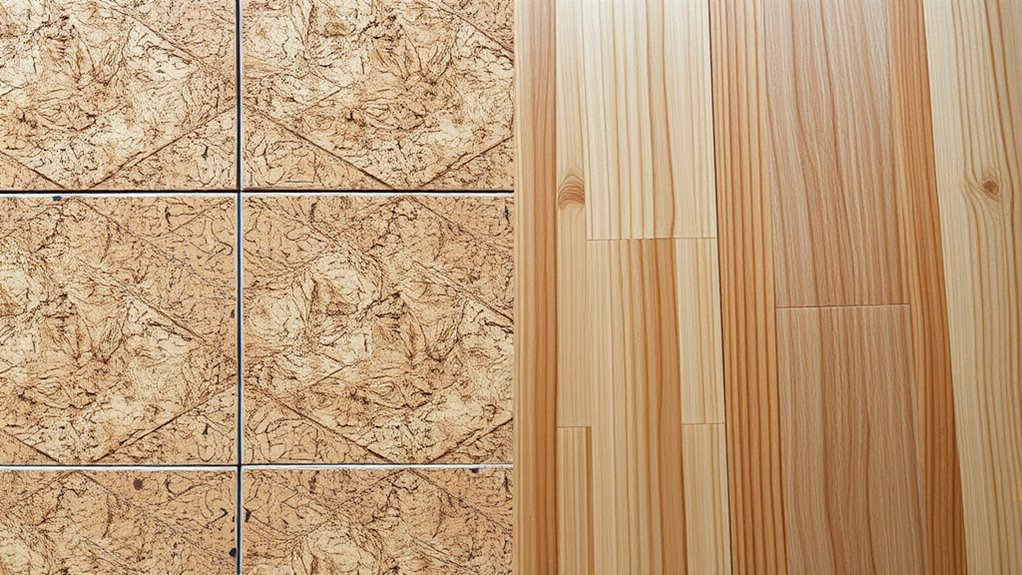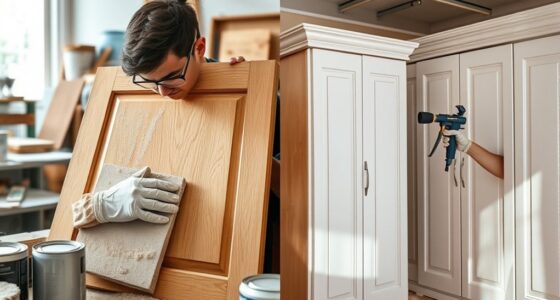Both cork and bamboo flooring are eco-friendly options that suit sustainable living. Bamboo grows quickly and can be harvested every 3-5 years, making it highly renewable, while cork is harvested from bark without harming trees. Cork also repurposes waste from wine corks. However, their environmental impact depends on sourcing and manufacturing practices. To discover which material aligns best with your eco-conscious goals, explore their durability, comfort, and aesthetic qualities in more detail.
Key Takeaways
- Both cork and bamboo are biodegradable, eco-friendly flooring options, but bamboo’s rapid growth makes it more sustainable overall.
- Cork is harvested from regenerating bark without harming trees, while bamboo’s quick growth allows for sustainable harvesting practices.
- Bamboo generally has a higher durability and hardness, extending its eco-friendly advantage through longer lifespan.
- Cork offers superior sound absorption and thermal insulation, enhancing environmental comfort and energy efficiency.
- The sustainability of bamboo depends on sourcing and manufacturing practices; cork’s harvesting process is inherently eco-friendly.

When choosing between cork and bamboo flooring, understanding their key differences can help you make an informed decision. Both materials are eco-friendly options, but they differ considerably in sustainability, durability, comfort, moisture resistance, and aesthetics. Knowing these distinctions allows you to select the best flooring for your needs and values. Bamboo is celebrated for its rapid renewability. It grows incredibly fast, reaching harvestable size in just 3 to 5 years, making it one of the most sustainable flooring materials. In contrast, cork is harvested from the bark of cork oak trees, which regenerates every 9 to 12 years. This process leaves the tree intact, so cork harvesting is highly sustainable. Both materials are biodegradable, reducing their environmental impact at the end of their lifecycle. Additionally, cork production often uses byproducts from wine cork manufacturing, further minimizing waste. While bamboo generally has a low environmental footprint, the sustainability of bamboo flooring can vary depending on manufacturing practices and sourcing. Sustainable harvesting methods are essential to maximize environmental benefits. In terms of durability, bamboo generally outperforms cork. Strand-woven bamboo ranks around 1,800 on the Janka hardness scale, with some proprietary treatments reaching up to 5,000, making it suitable for high-traffic areas. Cork, on the other hand, is much softer, scoring approximately 200 on the Janka scale, which makes it more susceptible to dents, scratches, and damage from heavy furniture or pet claws. While bamboo is more resistant to scratches and heavy use, cork offers a softer, more forgiving surface that cushions impacts. Both types of flooring require proper installation and maintenance to guarantee longevity and durability. When it comes to comfort and feel, cork provides a softer, cushiony surface that’s gentle underfoot. Its natural sound absorption makes it ideal for apartments, condos, or multi-story homes, as it helps reduce noise and impact sounds. Cork also boasts high thermal insulation, keeping floors warmer in cooler climates. Bamboo, being firmer, offers less cushioning but provides a stable, traditional hardwood feel. It tends to be cooler and less insulating than cork, which might be a consideration in colder environments. Moisture resistance varies between the two. Bamboo is naturally moisture-resistant but can warp if not properly sealed or exposed to prolonged moisture. Cork, when sealed, resists moisture well but isn’t waterproof. Spills should be cleaned quickly to prevent damage. Neither material is suitable for bathrooms or basements with high humidity, though cork’s cushioning and moisture resistance make it a decent choice for kitchens with proper maintenance. Both materials benefit from good sealing and routine care to maintain their moisture resistance. Aesthetic options also differ. Bamboo offers a sleek, modern look with shades ranging from light to dark, mimicking hardwood grain patterns. Cork provides warm, natural tones and can be stained or colored in various ways, allowing for customization. Cork tiles can be cut into unique shapes and patterns, adding a creative touch to your space. Overall, bamboo presents a more uniform, contemporary appearance, while cork’s natural, textured look adds warmth and character to any room.
Frequently Asked Questions
Which Flooring Type Is More Cost-Effective Long-Term?
You’re wondering which flooring saves you more money in the long run. Bamboo tends to be more cost-effective because it’s durable, requiring less frequent repairs and refinishing, which cuts maintenance costs. Cork is cheaper initially but may need more frequent repairs due to its softness and lower resistance to wear. Overall, bamboo’s longevity and lower upkeep make it a smarter, more economical choice over time, despite higher upfront costs.
How Do Cork and Bamboo Flooring Perform in High Humidity?
Imagine the dance of moisture on your floor—cork and bamboo react differently. You should know that cork isn’t ideal for high humidity unless treated, as it absorbs moisture and can swell. Bamboo, on the other hand, performs better when sealed properly, resisting moisture if humidity is controlled. Still, both need sealing and consistent humidity management to prevent warping, especially in bathrooms or basements.
Are There Specific Maintenance Requirements for Each Flooring?
You need to follow specific maintenance routines for each flooring type to keep them in good shape. For cork, regularly sweep or vacuum, wipe spills immediately, and use pH-neutral cleaners. Maintain proper humidity levels to prevent warping, and consider applying additional protective coats in high-traffic areas. For bamboo, keep it clean with gentle sweeping or vacuuming, avoid excess water, and periodically seal the surface. Both floors benefit from furniture pads and indoor humidity control.
Which Flooring Is More Resistant to Scratches and Dents?
You might worry about scratches and dents ruining your beautiful floor, but bamboo is more resistant than cork. Its high hardness, especially strand-woven bamboo, keeps it looking newer longer, even in high-traffic areas. Cork, while soft and comfy, dents easily from heavy furniture. So, if durability and scratch resistance matter most, bamboo’s your best bet for maintaining a pristine look over time.
How Do Cork and Bamboo Flooring Impact Indoor Air Quality?
You’re wondering how cork and bamboo flooring affect indoor air quality. Cork is naturally VOC-free, helping you breathe easier and resisting mold and allergens thanks to its antimicrobial properties. Bamboo may have low-emission finishes, but chemical adhesives used in manufacturing can release VOCs. Both materials, when properly finished and maintained, improve indoor air quality—cork especially for humid spaces—making your home healthier and more comfortable.
Conclusion
Ultimately, whether you choose cork or bamboo flooring, you’re making an eco-friendly choice that benefits both the planet and your home. Cork offers a soft, warm feel, while bamboo provides durability and a modern look. Think of it as choosing between a cozy cottage or a sleek spaceship—both are sustainable options that help save the Earth. Whichever you pick, you’ll be stepping into a greener future, just like the pioneers of old who believed in progress and preservation.









